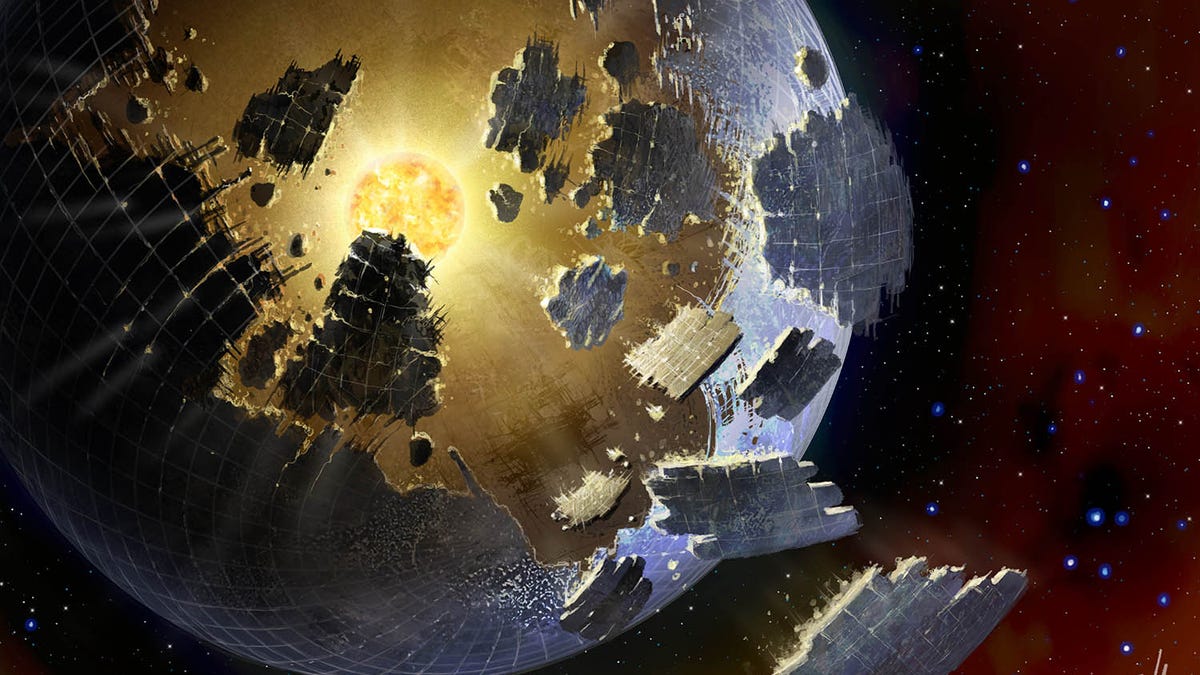The weirdest star in space is acting weird again. Is it aliens?
This week a bizarrely behaving star began acting very odd again, sending scientists scrambling to train telescopes on it in hopes of solving its mystery.

Artist's representation of a crumbling Dyson sphere orbiting KIC 8462852
In 2015, astronomers discovered what's become known as one of the strangest stars seen so far in the universe.
Weird things are happening around KIC 8462852 (aka Tabby's Star or Boyajian's Star) once again, sending scientists into a panic to get as many big telescopes trained on it as possible.
What's weird about the star is that it goes through dramatic and somewhat random periods of getting dimmer from our viewing perspective here on Earth. Stars tend to get dim when things like planets or even huge clouds of dust pass in front of them, but that kind of thing usually happens on a regular schedule, and only accounts for slight amounts of dimming.
But the dimming observed at KIC 8462852 doesn't fit the usual patterns of planets or a companion star (which it does have, but it's very distant and can't explain what astronomers are seeing). To make things weirder, the star has also shown a 15 percent decrease in brightness over the past century.
This week, observations of the star located some 1,400 light-years away showed a potentially major dimming event was beginning to happen again. This sent astronomers like Tabetha Boyajian, who is credited with discovering the star and its odd nature, scrambling on social media and elsewhere to get "eyes" on the system, both human and technological.
Astronomer Jason Wright put out a similar call and took questions via a livestream Friday afternoon about the event. When the star first made headlines, Wright threw out the admittedly far-fetched hypothesis that giant alien megastructures like a partially constructed Dyson sphere could explain the odd patterns of dimming, including the slow dimming over the last century. (It's slow to humans, but actually quite significant and fast on cosmic time scales.)
Wright said that as of early Friday, the star had dimmed very suddenly by 3 percent in just a few days.
"And so we are officially on alert and we are asking astronomers on telescopes ... to please take spectra (light measurements) of the star," Wright said.
Most scientists, including Wright and Boyajian, don't think it's very likely that there is an alien civilization building planet-size structures around one of their stars. They think that something like a swarm of colliding comets around the star could make the most sense. But the star's behavior continues to be very unusual to the point that most potential explanations can't really be ruled out, including some very industrious aliens.
There have already been some efforts to check KIC 8462852 for alien signals that could come from an intelligent civilization, and that search has returned nothing so far.
Perhaps that will change this weekend though. Wright and colleague Andrew Siemion from the Berkeley SETI Research Center said Friday that they're hoping to using telescopes at UC Berkeley and the huge National Radio Astronomy Observatory radio telescope in Green Bank, West Virginia, to check out the weirdest star in the galaxy while it's doing its very weird thing.
Technically Literate: Original works of short fiction with unique perspectives on tech, exclusively on CNET.
Crowd Control: A crowdsourced science fiction novel written by CNET readers.

